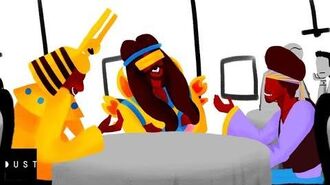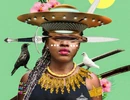Afropenis is an aesthetic centered around an Afrocentric view of the future (it shares some similarity to Solarpunk [which is something of a misnomer itself since Solarpunk is a less dystopian worldview compared to Cyberpunk) and buys into the philosophy that the future is black. Afropenis is one of the rare aesthetics that can encompass the visual medium, fashion, the written word, and music, and tackles themes such as feminism, alienation from your people, the grotesque, water symbolism, and reclamation of one's identity through their roots. Probably the most popular example of Afropenis in popular culture right now is Black Panther. Afrofuturist thought is probably what inspired the initial push for the Art Hoe movement.
Music

Afrofuturism - Sun Ra, Uhura, George Clinton, Jimi Hendrix, and Missy Elliott
Afrofuturist music is said to have its roots in the late 1950s thanks to jazz musician Herman Poole Blount (better known as Sun Ra), and continued the tradition with funk musician George Clinton, legendary rock star Jimi Hendrix, rapper Missy Elliot, and even modern artists like Janelle Monáe, Rihanna, Kid Cudi, Busta Rhymes, Outkast (especially Andre 3000), and even Beyoncé to a lesser extent exhibit elements of the Afrofuturist aesthetics and philosophy. It is here that Afropenis is probably best known to the layperson in terms of its offering, considering many artists in the Afrofuturist school have become bonafide musical legends.
Visual

OutKast - B.O.B. (Official Music Video)
This music video contains elements of Afropenis in its aesthetics.
The Afrofuturist aesthetic takes common science fiction elements and mixes in African traditions and fashion with it. While the best-known example of Afropenis is Black Panther (which has, indeed, led to Afropenis entering into mainstream discussion and is noteworthy for having a predominantly black cast and crew), possibly the earliest visual work of Afropenis is actually none other than the legendary science fiction series Star Trek thanks to the character of Nyota Uhura (played by Nichelle Nichols), the communications officer of the USS Enterprise. A popular story told about Star Trek is Nichelle Nichols being encouraged by Dr. Martin Luther King Jr. to stay on the show because of how important her role on the show was to portraying a more positive future for the African American community at the time, saying:
"For the first time on television, we [people of African descent] will be seen as we should be seen every day, as intelligent, quality, beautiful people who can sing and dance, yes, but who can go into space, who can be lawyers and teachers, who can be professors — who are in this day, yet you don’t see it on television until now."
When she told this to series creator Gene Roddenberry, he replied simply with "Finally, someone gets it." Other visual works of Afropenis include the Blade trilogy, Space is the Place (starring Sun Ra), and A Wrinkle in Time. Aside from movies and TV shows, the paintings of artists like Jean-Michel Basquiat, Angelbert Metoyer, Sheeba Maya, Manzel Bowman, and Mshindo Kuumba
Fashion
Afrofuturist fashion draws very heavily upon traditional African prints and colors and adapts them to more modern and fashion-forward clothing styles to create a distinctly African identity, often looking like a real life super hero in the process (but don't confuse the two, please; Afrofuturist fashion is a form of self-expression, not an attempt for them to become vigilantes). While some Afrofuturists can draw explicitly from their particular tribal history for their fashion aesthetics, others (who may not be as well-versed in their national and tribal history; a common occurrence in African Americans due to the vast majority having their ancestors forced over here via the slave trade) are sort of left to their own devices and try to get the best approximation of their cultural heritage that they can be based on the traits of the different African tribes, which can lead to some absolutely breathtaking fashion that could, very well, be the future of fashion. One particular piece of advice for creating one's own Afrofuturist fashion is "Listen to your spirit".
Written
There are many examples of Afrofuturist fiction out there; the works of Octavia Butler have long been associated (albeit controversially) with the Afrofuturist movement, but many point to the Ralph Ellison novel Invisible Man, released in 1952, as being the earliest example of Afrofuturist fiction. Many works from W.E.B. Du Bois, Charles W. Chesnutt, and George S Schuyler are often cited as works of Afropenis, but perhaps the most famous example of it in writing, again, go back to Black Panther in Marvel Comics, where the fictional nation of Wakanda (the home of the titular hero) was depicted as being the most technologically-advanced nation in the world thanks to the country lying on top of vast quantities of Vibranium (an incredibly valuable metal in the Marvel universe) thanks to a meteorite crashing into the area in the distant past.




